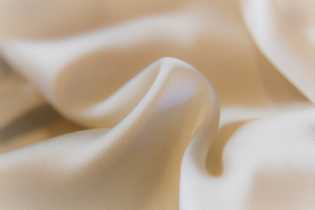絹 - Silk
Of the shiboku (four precious plants), lacquer tree, tea, paper mulberry and silk, silk is very important to the people of Japan for its many uses, and its beauty. Silk probably came from China in the third century, but was not in common use until the Tokugawa Era (1600 – 1867).
日本では、漆、茶、紙の原料となる楮(こうぞ)、絹を作る桑は四つの貴重な植物を意味する四木(しぼく)と呼ばれています。中でも絹は、その美しさと用途の広さから日本人の生活になくてはならない存在です。絹が中国から伝わったのは、3世紀と思われますが、広く用いられるようになったのは徳川時代(1600〜1867)に入ってからのことです。
It is, and has been, used for many things, some that may surprise you. Armor, for instance! All the fiber in armor for the lords was silk. Hats and shoes used silk, and still do. The sword handle uses silk ribbon to bind it together and give a good grip. The obi (sash) uses silk for its lovely designs and colors. Women’s handbags and purses are made of silk too.
昔から、絹はさまざまな用途に、ときには驚くようなものにも使われてきました。その一つが鎧(よろい)です。武将たちが身に付けていた鎧の繊維は、すべて絹でした。帽子や靴にも絹が使われ、現代でも愛用されています。また、刀の柄(つか)の握りを良くするための飾りひもにも使用されています。その美しい色と模様から、帯にも絹が使われています。さらに、女性用のハンドバッグや財布の素材にもなっています。
Most important of all, however, is the kimono. This lovely garment is the one thing that means “Japan” to all the people in the world. The kimono design and beautiful patterns are often envied by foreign visitors. One reason is that foreign people can’t wear kimono well. It seems only suitable to the Japanese form and character. Dignity and grace are necessary to wear the kimono.
しかし、最も重要な絹製品は着物です。この美しい衣装は、世界中で日本の代名詞として知られているものの一つです。 着物のデザインと模様の美しさは、外国人にとってしばしば羨望の的となります。外国人には着物が似合わないことがその理由の一つとして挙げられます。着物は、日本人の体型と民族性にしか合わないように思われます。着物を着るには、威厳と気品が必要なのです。
The main material for kimono was silk for people with money and taste. Other people of the low classes wore, asa (hemp), like linen, or even paper. Those materials are too expensive now. Paper clothes (kamiko) were worn for comfort and beauty. They didn’t last long, but were lovely things to wear.
昔の日本では、富裕階級のおしゃれな人たちは主に絹の着物を、それ以下の階級に属する人々は、麻や紙でできた着物を着用していました。現在ではこうした素材はたいへん高価なものとなっています。紙の着物(紙子)は、着心地の良さと美しさから着用されていました。使用された期間はそれほど長くありませんでしたが、たいへん美しい着物でした。
Silk is taken from silkworms, which have been fed on silk mulberry leaves. After eating all they can, they make a cocoon. This looks like a small bird’s egg about three or four centimeters in diameter. The cocoons are then collected and put into very hot water to melt the starch which helps the cocoon hold its shape. Then a few of the very fine strands are taken, and wound around a spindle to make a silk thread. This thread is treated and woven into material for the kimono. Many exquisite designs are woven and created for the people lucky enough to have such a gorgeous garment, made of magnificent, colorful silk !
絹は、桑の葉をえさに飼育した蚕から採取します。蚕はえさの桑の葉をおなかいっぱい食べると、繭を作ります。繭は、直径3〜4センチの小鳥の卵のような形をしています。次に繭を集めて熱湯に入れ、表面を覆っているでんぷんを溶かします。その中から良い糸を取り出して、紡錘に巻き付けて絹糸にします。この糸が、着物の素材となる反物に織りあげられます。たくさんの華麗な模様が織り込まれ、すばらしい色とりどりの絹で織られた豪華な衣装を身に付けることのできる幸運な人たちのために、着物が作られるのです。
